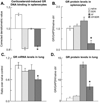Social stress enhances allergen-induced airway inflammation in mice and inhibits corticosteroid responsiveness of cytokine production
- PMID: 19494313
- PMCID: PMC2767120
- DOI: 10.4049/jimmunol.0800891
Social stress enhances allergen-induced airway inflammation in mice and inhibits corticosteroid responsiveness of cytokine production
Erratum in
- J Immunol. 2009 Sep 1;183(5):3551. Amrani, Yassine [added]
Abstract
Chronic psychosocial stress exacerbates asthma, but the underlying mechanisms remain poorly understood. We hypothesized that psychosocial stress aggravates allergic airway inflammation by altering innate immune cell function. The effects of stress on airway inflammation, lung function, and glucocorticoid responsiveness were studied in a novel in vivo murine model of combined social disruption stress and allergic sensitization. The effects of corticosterone were assessed on cytokine profile and glucocorticoid receptor activation in LPS-stimulated spleen cell cultures in vitro. Airway inflammation resolved 48 h after a single allergen provocation in sensitized control mice, but not in animals that were repeatedly exposed to stress before allergen challenge. The enhanced eosinophilic airway inflammation 48 h after allergen challenge in these mice was associated with increased levels of IL-5, GM-CSF, IgG1, thymus-activated and regulatory chemokine, TNF-alpha, and IL-6 in the airways and a diminished inhibition of these mediators by corticosterone in LPS-stimulated splenocyte cultures in vitro. Stress-induced reduction of the corticosteroid effects paralleled increased p65 expression and a decreased DNA-binding capability of the glucocorticoid receptor in vitro. Furthermore, glucocorticoid receptor mRNA and protein expression in the lungs of mice exposed to both stress and allergen was markedly reduced in comparison with that in either condition alone or in naive mice. Thus, exposure to repeated social stress before allergen inhalation enhances and prolongs airway inflammation and alters corticosterone responsiveness. We speculate that these effects were mediated at least in part by impaired glucocorticoid receptor expression and function.
Figures





References
-
- Isenberg SA, Lehrer PM, Hochron S. The effects of suggestion and emotional arousal on pulmonary function in asthma: a review and a hypothesis regarding vagal mediation. Psychosom. Med. 1992;54:192–216. - PubMed
-
- Lehrer PM, Isenberg S, Hochron SM. Asthma and emotion: a review. J. Asthma. 1993;30:5–21. - PubMed
-
- Beggs PJ, Curson PH. An integrated environmental asthma model. Arch. Environ. Health. 1995;50:87–94. - PubMed
-
- Heim C, Ehlert U, Hellhammer DH. The potential role of hypocortisolism in the pathophysiology of stress-related bodily disorders. Psychoneuroendocrinol. 2000;25:1–35. - PubMed
-
- Marshall GD, Jr, Agarwal SK. Stress, immune regulation, and immunity: applications for asthma. Allergy Asthma Proc. 2000;21:241–246. - PubMed

